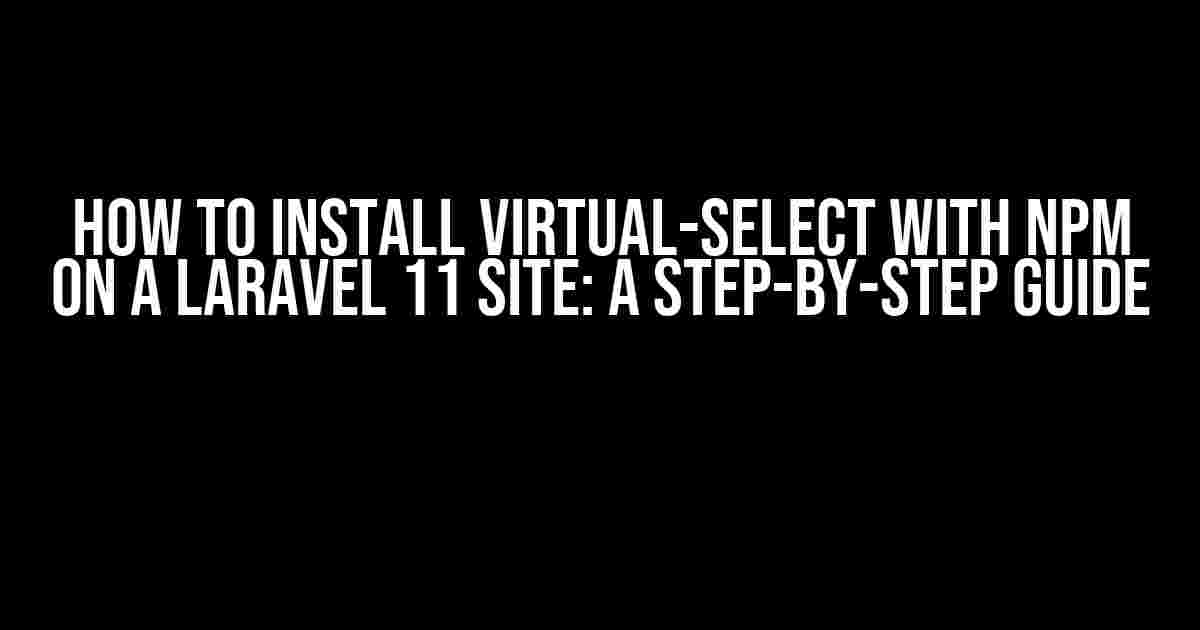Welcome to this comprehensive guide on installing Virtual-Select with npm on a Laravel 11 site! Virtual-Select is a popular JavaScript library that provides an efficient and customizable way to handle large datasets in dropdown lists. In this article, we’ll take you through the entire process of installing and setting up Virtual-Select on your Laravel 11 site using npm.
- What is Virtual-Select?
- Why Use Virtual-Select with Laravel 11?
- Prerequisites
- Step 1: Install Virtual-Select using npm
- Step 2: Include Virtual-Select in your Laravel 11 Project
- Step 3: Configure Virtual-Select Options
- Step 4: Render Virtual-Select in your Laravel 11 View
- Step 5: Integrate Virtual-Select with Laravel 11 Form Requests
- Conclusion
What is Virtual-Select?
Before we dive into the installation process, let’s take a brief look at what Virtual-Select is and why it’s so useful. Virtual-Select is a lightweight, highly customizable JavaScript library that enables you to work with large datasets in dropdown lists efficiently. It provides a robust and scalable solution for handling massive datasets, making it an ideal choice for complex web applications.
Why Use Virtual-Select with Laravel 11?
Laravel 11 is a popular PHP framework that provides a robust and scalable foundation for building web applications. By combining Laravel 11 with Virtual-Select, you can create powerful and efficient dropdown lists that can handle large datasets with ease. Virtual-Select’s lightweight and customizable nature makes it an excellent fit for Laravel 11 applications.
Prerequisites
Before you begin, make sure you have the following prerequisites in place:
- Laravel 11 installed on your system
- npm (Node Package Manager) installed on your system
- A basic understanding of JavaScript and Laravel 11
Step 1: Install Virtual-Select using npm
Open your terminal and navigate to your Laravel 11 project directory. Then, run the following command to install Virtual-Select using npm:
npm install virtual-selectThis command will download and install Virtual-Select and its dependencies in your project directory.
Step 2: Include Virtual-Select in your Laravel 11 Project
Once Virtual-Select is installed, you need to include it in your Laravel 11 project. Create a new JavaScript file in your project’s public directory (e.g., public/js/script.js) and add the following code:
import VirtualSelect from 'virtual-select';
// Initialize Virtual-Select
const virtualSelect = new VirtualSelect({
// Configure Virtual-Select options here
});
This code imports Virtual-Select and initializes it with default options. You can customize the options to suit your needs.
Step 3: Configure Virtual-Select Options
Virtual-Select provides a range of options for customizing its behavior. Here are some common options you can configure:
| Option | Description |
|---|---|
| items | The dataset to be rendered in the dropdown list |
| itemHeight | The height of each item in the dropdown list |
| scrollHeight | The height of the dropdown list scrollbar |
| placeholder | The placeholder text to display when no items are selected |
Here’s an example of how you can configure Virtual-Select options:
const virtualSelect = new VirtualSelect({
items: [
{ id: 1, label: 'Item 1' },
{ id: 2, label: 'Item 2' },
{ id: 3, label: 'Item 3' },
// ...
],
itemHeight: 30,
scrollHeight: 200,
placeholder: 'Select an item',
});
Step 4: Render Virtual-Select in your Laravel 11 View
Now that you’ve configured Virtual-Select, it’s time to render it in your Laravel 11 view. Create a new Blade template (e.g., resources/views/virtual-select.blade.php) and add the following code:
<div id="virtual-select"></div>
<script>
const virtualSelect = new VirtualSelect({
// Configure Virtual-Select options here
});
virtualSelect.render('#virtual-select');
</script>
This code renders the Virtual-Select dropdown list in the #virtual-select div element.
Step 5: Integrate Virtual-Select with Laravel 11 Form Requests
To integrate Virtual-Select with Laravel 11 form requests, you need to create a form request class that handles the dropdown list data. Create a new form request class (e.g., app/Http/Requests/VirtualSelectRequest.php) and add the following code:
<?php
namespace App\Http\Requests;
use Illuminate\Foundation\Http\FormRequest;
class VirtualSelectRequest extends FormRequest
{
public function rules()
{
return [
'virtual_select' => 'required',
];
}
}
This code defines a form request class that validates the Virtual-Select dropdown list data.
Conclusion
In this comprehensive guide, we’ve covered the entire process of installing and setting up Virtual-Select with npm on a Laravel 11 site. With Virtual-Select, you can create powerful and efficient dropdown lists that can handle large datasets with ease. By following these steps, you can integrate Virtual-Select into your Laravel 11 application and take your dropdown lists to the next level.
Remember to customize Virtual-Select options to suit your specific needs and explore its advanced features to maximize its potential. Happy coding!
Troubleshooting Tips
If you encounter any issues while installing or setting up Virtual-Select, here are some troubleshooting tips to help you:
- Check the Virtual-Select documentation for the latest installation instructions and configuration options.
- Verify that you have the correct versions of npm and Laravel 11 installed.
- Review your code for any syntax errors or typos.
- Check the console for any error messages or warnings.
Frequently Asked Questions
Here are some frequently asked questions about installing and setting up Virtual-Select with npm on a Laravel 11 site:
-
Q: What is the minimum version of Laravel required for Virtual-Select?
A: Virtual-Select is compatible with Laravel 8.x and above.
-
Q: Can I use Virtual-Select with other JavaScript libraries?
A: Yes, Virtual-Select is designed to work with other JavaScript libraries and can be easily integrated into your existing tech stack.
-
Q: Is Virtual-Select compatible with mobile devices?
A: Yes, Virtual-Select is fully responsive and works seamlessly on mobile devices.
We hope this guide has been helpful in installing and setting up Virtual-Select with npm on your Laravel 11 site. If you have any further questions or need additional assistance, don’t hesitate to ask!
Here are the 5 Questions and Answers about “How to install virtual-select with npm On laravel 11 site” in HTML format:
Frequently Asked Question
Get answers to the most commonly asked questions about installing virtual-select with npm on Laravel 11 site.
What is the first step to install virtual-select with npm on Laravel 11 site?
The first step to install virtual-select with npm on Laravel 11 site is to open your terminal and navigate to the root directory of your Laravel project. This is where the magic happens!
How do I install virtual-select using npm on my Laravel 11 site?
To install virtual-select using npm, simply run the command `npm install virtual-select` in your terminal. This will download and install virtual-select and its dependencies.
Do I need to update my Laravel 11 site’s package.json file after installing virtual-select using npm?
Yes, after installing virtual-select using npm, you need to update your Laravel 11 site’s package.json file by running the command `npm run dev` to reflect the changes.
How do I import virtual-select in my Laravel 11 site’s JavaScript file?
To import virtual-select in your Laravel 11 site’s JavaScript file, simply add the line `import VirtualSelect from ‘virtual-select’;` at the top of your JavaScript file.
Can I use virtual-select with other libraries and frameworks on my Laravel 11 site?
Yes, virtual-select is designed to work with other libraries and frameworks, including Vue.js, React, and jQuery. You can use virtual-select along with other libraries and frameworks on your Laravel 11 site without any issues.


